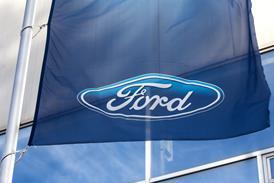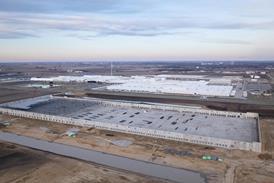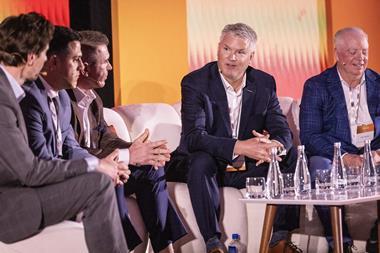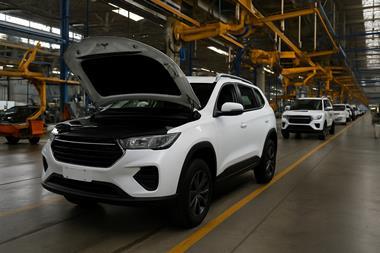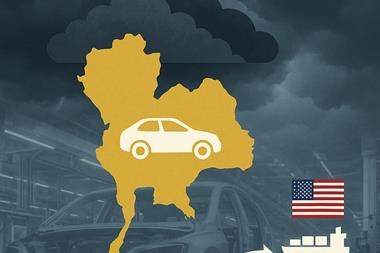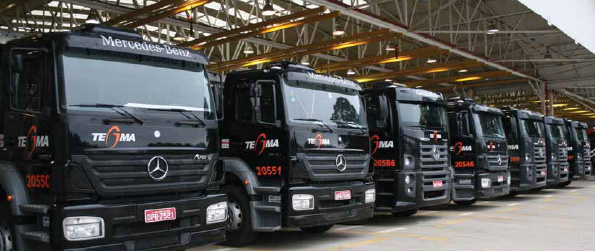
New legislation and a volatile market are hurting road haulage companies in Brazil. Tony Danby assesses the scenario for vehicle road haulage in Latin America’s largest market.
Brazil’s road haulage segment for finished vehicles is already dominated by a small number of companies and suffers from a lack of rail and multimodal transport, depending almost entirely on a road network of which only 6% is paved. As if those challenges weren’t enough, this year logistics providers face a volatile market for new vehicles as well as new legislation that has many companies worried about rising costs and lower efficiency. A growing driver shortage, for example, looks likely to be compounded by restrictions on driving times.
But executives from OEMs and logistics providers also have reasons to be optimistic about Brazil’s outlook for the future. As OEMs invest to increase vehicle production in various parts of the country, the Brazilian government has also promised hefty investment in infrastructure that could boost demand and ease existing bottlenecks. Beside the potential growth of the market and investment by the government, manufacturers and logistics providers in Brazil are also taking measures to improve their own networks and operations. Brazilian vehicle logistics provider Tegma, for example, is developing a network of subhubs and terminals across Brazil to improve delivery precision and efficiency. Global logistics provider Gefco is also making further investments in technologies such as radio frequency identification (RFID) to improve tracking.
their own networks and operations. Brazilian vehicle logistics provider Tegma, for example, is developing a network of subhubs and terminals across Brazil to improve delivery precision and efficiency. Global logistics provider Gefco is also making further investments in technologies such as radio frequency identification (RFID) to improve tracking.
Safety legislation could worsen driver shortage
The new legislation – known in Brazil as Lei 12,619/2012 – will restrict the number of hours truck drivers can work. Currently, long-distance drivers spend many hours on the road, but in future they will be restricted from driving for more than four hours without a break of at least 30 minutes. They will also be restricted to trips of up to eight hours a day.
Henrique Machado, logistics director at tractor manufacturer Agco, says that the driving restrictions will lead to a significant decrease in the ten trips per truck each month that transport providers often complete. “This means trucks will deliver less cargo at the same expense, which could raise costs by at least 20%,” he says.
The legislative issue may be a necessary safety measure for Brazil’s roads – Machado admits that it should dramatically reduce accidents – but it is likely to compound other issues, such as the lack of many basic rest-stop and parking facilities along motorways. If drivers do not have adequate places to park and rest, industry experts point out that the risk to the safety of drivers and cargo will increase.
Stephan Gruener, managing director of BLG Logistics Brazil, a joint venture between Germany’s BLG and Mosolf, warns that the situation is even more acute in the north and northeast of Brazil where there are even fewer facilities. “While in the past only 30% of trucks stopped at certain rest points, now the law will force a much larger proportion of truckers to stop,” he says.
The reduction in driver hours is also likely to aggravate capacity issues, particularly the growing shortage of qualified drivers. Not every logistics provider has the time and resources to train drivers, which will worsen the shortages, says Machado. With unemployment hovering around 6% – considered nearly full employment in Brazil – the labour market is unlikely to produce the required increase in drivers, either.
Gruener stresses that it is important to understand the impacts on certain routes to know how to adjust the company’s processes and loads, as well as to increase equipment productivity. BLG Logistics – known as BMS Logística in Brazil until recently – outsources about half of its volumes to third-party trucking companies and is already mapping out which processes will be hit hardest on key routes such as from Manaus and Belem in the north to cities such as Fortaleza, João Pessoa or Recife.
The executive explains that close cooperation between transport companies and trade unions will be essential to adjust the structure for rest facilities. BLG Logistics is also trying to share its loads between clients as well as mix cargoes of various sectors to offset the additional costs, Gruener says.
At the same time as the new regulations are coming into operation, the market is also seeing weaker production volume for new vehicles. Domestic sales increased 1.8% in the first seven months of the year to 2.08m, before accelerating to record levels in August, driven in large part by tax breaks that were originally due to expire in September (but which were then extended to at least October). Otherwise, the economy has been taking hits related to the financial crisis in Europe and tighter credit availability, with the commercial vehicle sector in particular suffering from lower sales. As a result, manufacturers have been slimming inventory, with production of cars, buses and trucks lower compared to 2011.
The Brazilian government has responded with tax breaks and credit-easing measures. On the international front, it has cut interest rates in an effort to depreciate the Brazilian real, which surged in 2011 but has since pulled back, and it also put up several barriers intended to protect Brazilian-based manufacturing, including a 30% import duty on cars built outside the Mercosur region and a renegotiated a trade accord with Mexico on vehicle imports. Moreover, the government has promised investment to improve outdated and overburdened infrastructure. Although transport companies continue to face challenges on roads often strewn with potholes, there are now various initiatives to improve the highway conditions.
The government envisages that this package will help to increase Brazil’s GDP growth, which is hovering below 2% this year, down significantly from 7.5% in 2010. In mid-August, President Dilma Rousseff announced a major stimulus programme, with the centrepiece being R$133 billion ($65.5 billion) in financing and private concessions to build 7,500km of toll roads and 10,000km of railways to help ease bottlenecks in the country’s ageing infrastructure, which businesses have long complained is hampering the country’s growth.
Although the details of the plan remain uncertain, BLG’s Gruener points out that this is not the government’s first promise to invest heavily in resources for infrastructure. Despite delays, Brazil’s Programme for Growth Acceleration (PAC), now in its second phase, has already built over 600km of roads, more than ten airports and various port projects.
Gruener says that Brazil certainly needs investment in roads and ports to help reduce what those in the industry call the ‘custo Brasil’ (Brazil cost) related to custom delays, poor roads, and inadequate infrastructure. “All infrastructure investment will bring big benefits to the country, so we need this as fast as possible,” says Gruener.
While infrastructure investment could stimulate growth, Brazil’s automotive sector is still facing slowdowns in many segments. BLG, which moves a large volume of Honda motorbikes, has seen a major drop in the two-wheeler market, moving 25% fewer motorbikes in the first half of this year compared to last year. Many potential buyers have struggled to obtain financing after banks tightened credit lines amid a higher level of delinquency.
Gruener explains that most motorbike customers are in the typically poorer northern regions, where the population is sensitive to tighter loan terms. Even R$100 can make a difference to these customer’s ability to pay, he adds.
With volumes stagnant or falling, Gruener says BLG Logistics has been looking for ways to juggle volumes to ensure that costs are not passed onto customers, admitting that managing a company through a declining market is a new situation in Brazil because in recent years the story has been primarily one of continuous growth.
One of those difficulties comes in working with BLG’s own subcontractors, which range from individuals who own their own trucks to larger, established providers. BLG is trying to keep steady volumes for these companies, Gruener explains, in an effort to maintain long-term relationships.
Tegma to spread its reach further
For many years two core players, Tegma Gestão Logística and Sada Transportes, have dominated Brazil’s road haulage market for finished vehicles. These companies use their own fleets, while they also work with subcontracted transport companies.
Although these two players dominate, below the surface is a highly fragmented market with almost 500,000 carriers and some 1.3m cargo vehicles, according to data from the National Register of Road Hauliers. The vast majority are independent truckers who own their trucks and work on a contractual basis for various larger groups.
According to Tegma’s chief executive officer Gennaro Oddone, the stock-exchange-listed company is Brazil’s market leader for transporting vehicles, offering transport, storage (including customs) and stock management services.
“Tegma has around 33% market share for transporting new, zero-kilometre finished vehicles,” says Oddone.
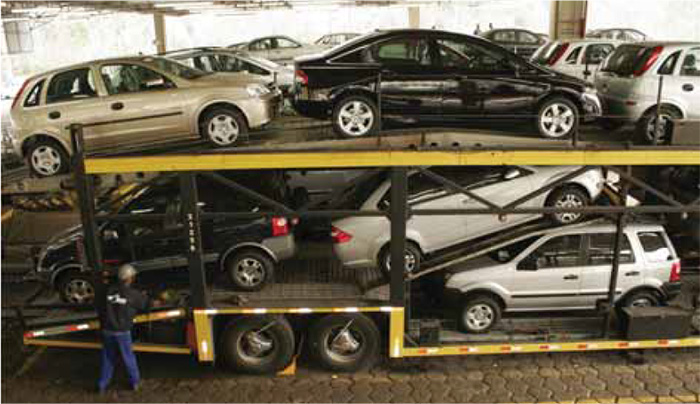
Last year, Tegma transported 1.3m cars – up 5.2% on the previous year. This year is already progressing well, according to Oddone, as Tegma transported 619,000 vehicles in the first half, up 6.1% year on year. The company’s gross revenue from vehicle logistics also rose 10.9% to reach R$625.7m in the first half, thanks mainly to the upturn in the number of vehicles transported and price adjustments.
After 40 years in the market, Tegma works with all of Brazil’s major customers. Besides finished vehicle logistics, the company carries out pre-delivery inspection, stock management, the installation of accessories, spare parts logistics and patio management.
In Oddone’s opinion, the challenge is to establish innovative solutions that deliver a competitive advantage for each client for specific demands and operational processes. As well as focusing on individual customer needs, Oddone believes that successful logistics companies in Brazil will focus more on solid practices and policies in terms of human resources, contract management, training and talent retention.
Indeed, Tegma’s expansion plans for this year and part of 2013 involve opening operational centres and sub-hubs in strategic regions. These new facilities will operate on an asset-light model, which means Tegma will rent warehouses and use local third parties. “The aim this year and ahead is to strengthen the relationship with current customers, identify existing business opportunities and develop innovative logistics solutions,” says Oddone.
He also sees further room for growth. There is a clear trend by manufacturers to outsource more logistics and value-added services in Brazil, he explains. At the same time, carmakers are also tending to unify more logistics operations with a single provider that has the ability to carry out the full chain of logistics activities, perhaps in combination with its own subcontractors. This goes hand in hand with the need to handle requests with a high quality of service, he adds.
Chinese vehicle importer CNAuto uses a local transport company called Alto Services that is affiliated to the Sada group. Alto handles Chinese-made vans and pick-ups that are shipped to Vitoria port, in Espirito Santo state, and then transported to around 75 destinations across Brazil.
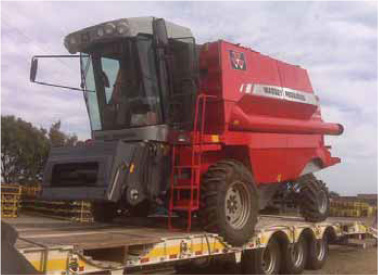 Alto Services handles on average about 1,500-2,000 vehicles each month for CNAuto, providing PDI and other logistics services. CNAuto selected the logistics company based on its quality and ability to provide access to a wide range of compounds and patios.
Alto Services handles on average about 1,500-2,000 vehicles each month for CNAuto, providing PDI and other logistics services. CNAuto selected the logistics company based on its quality and ability to provide access to a wide range of compounds and patios.
Although some market watchers complain that the dominance of the two top-tier players makes it difficult to break into the market, CNAuto’s Humberto Gandolpho Filho, commercial director, explains that despite the strong position of a few larger players, the quality of service remains high. The market governs the price, he says, noting that freight costs are some 5%-7% of the value of each new vehicle transported.
However, Gandolpho admits that the concentration of high market share among a few players, coupled with the high investment needed for assets, makes it very difficult for smaller trucking or logistics companies to enter the Brazilian market.
Gandolpho adds that Brazilian logistics is broadly similar to China, although more river transport is used in the Asian country. In China, logistics companies often also use doubledecker trailers or two connected ones, which is prohibited in Brazil for safety reasons (the Chinese government is now making more efforts to enforce a shorter truck length and stricter loading rules).
Brazilian-based manufacturer Agco delivers mainly tractors, combine harvesters and large crop sprayers to rural destinations from the grain belt of Mato Grosso state to farflung northern regions. These giant machines are transported by truck from inside Agco’s plants to around 300 dealerships. After this point, dealers or farmers are responsible for transporting the tractors to the final destinations. These largescale farmers usually own transport that is capable of carrying tractors, Henrique Machado explains.
For its tractors, Agco uses Atrhol, Coopercargo and Lisot, while for combines it uses Atrhol, Lisot and Romeu. These companies, which deploy a mix of their own fleet and contracted trucks, were chosen because of their experience in moving large farm machinery as well as their spread of patios and stockyards.
Beyond the standard 14-metre truck that carries two or three tractors, Agco also uses longer and wider trucks for specific products such as bigger tractors, and flat-beds for harvesters and sprayers. The company expects to increase the number of its longer trucks to load more tractors on the same trip. “We have undertaken some tests in partnership with transport companies to find new solutions for increasing capacity,” Machado says.
Agco has been tracking logistics performance and has seen damage decrease by a third since 2010. To avoid damage, Agco’s trucking companies have been using new upper and lower straps to avoid slippage or movement on the trailers. This helps to lessen the number of scratches and dents that result from collisions between finished products on the trailers, Machado says.
According to Macado, Agco has also been focusing on technology to ensure safety and efficiency. The company will stop using trucks once they are past ten years old, while all vehicles must be equipped with satellite surveillance. This satellite technology is important in risk management and for tracking logistics, he says. “This will help us to improve our controls in a market that offers a lot of potential for the future,” he adds.
Another company that has put a significant focus on using new technology to improve vehicle logistics in Brazil has been Gefco.
André Bortolotto, Gefco’s director of vehicle logistics, says that last year the company transported around 320,000 vehicles, but this year is likely to slow. “We had a difficult H1 [first half],” he admits.
Besides its current owners PSA Peugeot Citroën, Gefco works in Brazil for global carmakers such as Ford, GM, Renault, Toyota and BMW. Gefco also provides services such as collecting cars from the final production line, controlling the stock of tyres and batteries and washing cars.
The company’s main challenge is to build a network that can support the market growth as factories are increasingly spread across Brazil while the growth of new cars sales is still more concentrated in the south and southeast. Echoing many before him, he adds that there is also a need to overcome the difficulties of port infrastructure.
To help improve efficiency, Bortolotto says a benchmark practice for Gefco is to use RFID for tracking vehicles. The company uses a dedicated wireless network for PSA in Porto Real, with each vehicle receiving a smart tag with information such as a description, entry point and destination. Each tag sends various data to reading equipment, which then transmits it to a warehouse management system.
The system gives Gefco real-time data that makes it possible to map and immediately move vehicles, speeding up the decision-making process.
Such developments in IT and network management among both established and newer entrants in the South American market can only be positive. They reflect how the expansion of the Brazilian automotive market to new sales locations, combined with regulatory restrictions, is putting pressure on the vehicle logistics market to develop more advanced visibility and efficient processes.










